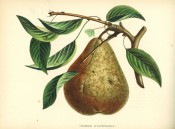Pyrus communis ‘Colmar d’Arenberg’
‘Fruit large, obovate, uneven, and bossed in its outline. Skin lemon coloured, marked with spots and patches of russet. Eye rather small and partially closed, set in a very deep round cavity. Stalk short, and rather slender, deeply inserted. Flesh yellowish-white, coarse-grained, half-melting, juicey, and briskly flavoured. A fine-looking but very coarse pear, ripe in October.’ [Hogg – Fruit Manual p.197/1860].
Horticultural & Botanical History
‘Attributed to Van Mons and thought to have originated in 1821.’ [Pears of New York p.341].
Named for Louis Prospeur, Duc d’Arenberg, born in Brussels in 1785. It was found on his estate and introduced in 1840. [Gard. Chron. 1860]. Figured in Le Jardin Fruitier du Muséum as ‘d’Arenberg’ [JFM t.II/1859] and in Album de Pomologie, [ADP vol.2, pl.109/1849] the illustration used here.
‘Size large; first quality; form obtuse pyriform; melting; a large and fine fruit; tree vigorous, and a great bearer.’ [NHM vol.1 p80/1864].
History at Camden Park
Listed only in the 1857 catalogue in an Addendum as ‘Blanc perne’ [Pear no.52/1850]. ‘52. Very large, melting, first rate.’ [Diary B, MP A2951/1862]. Obtained from Veitch’s Nursery, probably the original Exeter premises.
Notes
Published May 20, 2010 - 05:08 AM | Last updated Jul 22, 2011 - 03:32 AM
| Family | Rosaceae |
|---|---|
| Category | |
| Region of origin | Garden origin, Belgium |
| Synonyms | |
| Common Name | Dessert Pear, autumn |
| Name in the Camden Park Record |
Colmar d’Aremberg |
| Confidence level | high |


